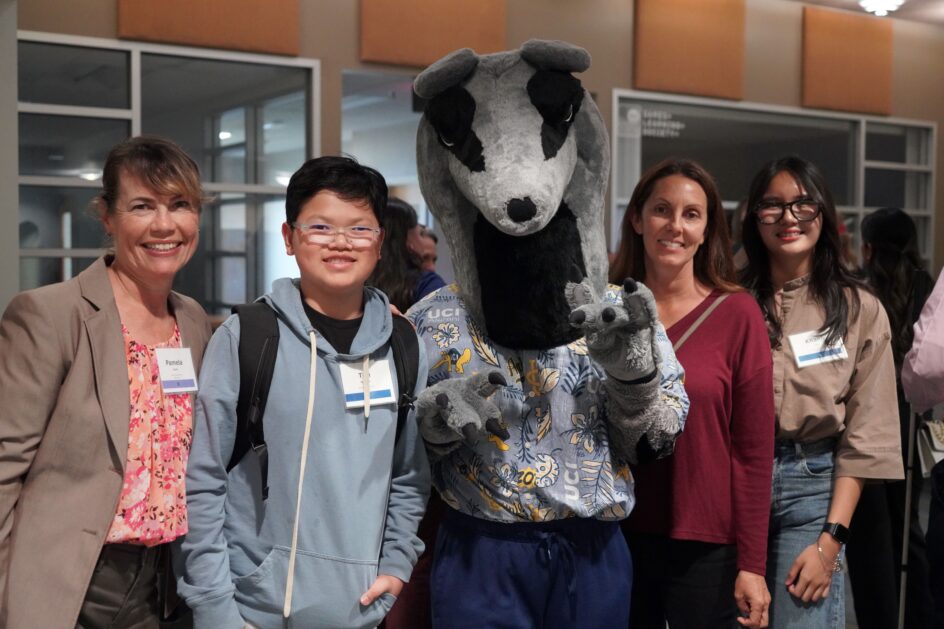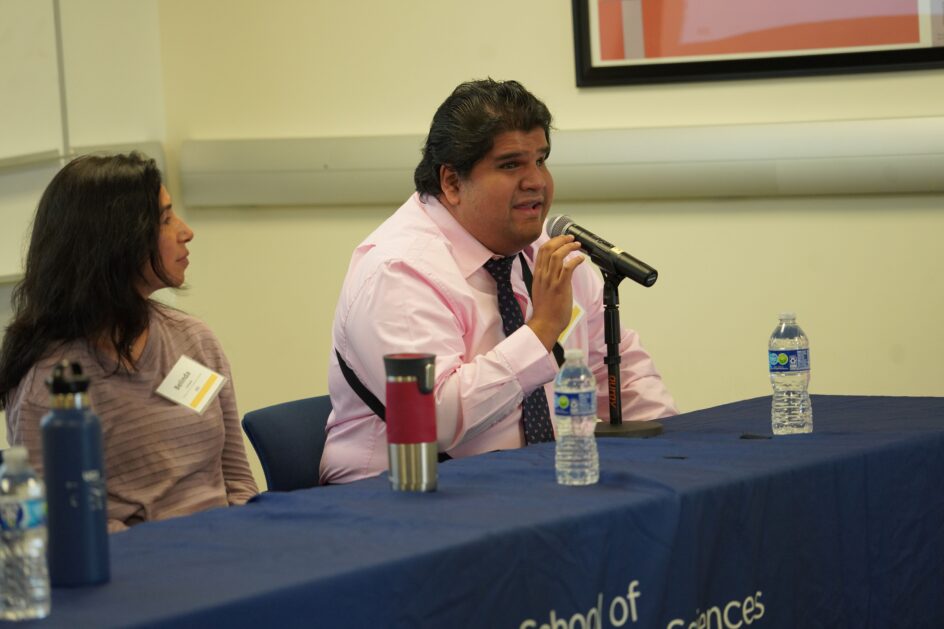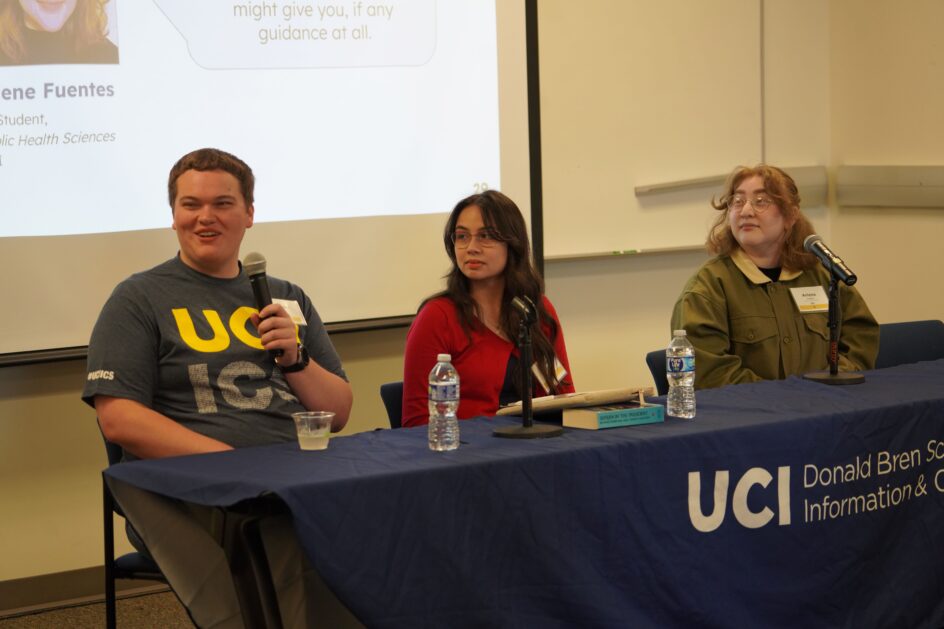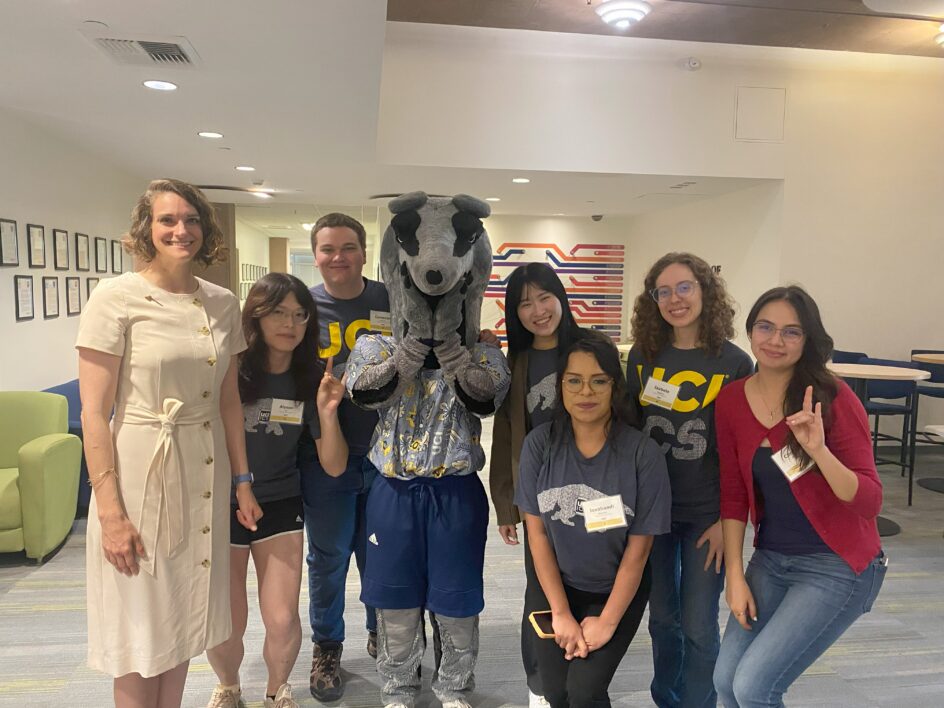Accessing STEM in Higher Education
For Disability Pride Month, we're spotlighting a recent event in which the School of ICS hosted high school students who are blind or low vision.

“When consequential decisions are being made, people with disabilities need to be in the room,” said Informatics Professor Stacy Branham, welcoming a group of high school students to UC Irvine on May 3, 2024. Although referring specifically to design decisions in the tech industry, her statement also offered a broad sense of encouragement to the group of blind and low vision (BLV) students visiting UCI’s Donald Bren School of Information and Computer Sciences (ICS).
Getting a seat at the “decision-making” table and increasing accessibility in STEM starts with making higher education more inclusive and accommodating. “Despite how common disabilities are,” notes a Best Colleges article, “society and institutions — like higher education — sometimes fail to provide adequate accommodations or truly inclusive spaces for all to participate equally.”
Understanding these challenges, Edwin Moos, a teacher for the visually impaired (TVI) in the Irvine Unified School District (IUSD), reached out to Branham last year. “He emailed me and said, ‘We don’t know how to prepare our students for college. Can you help?’”
As a founding member of UCI’s Accessibility Research Collective (ARC) and director of the INclusive Studio for Innovative Technology and Education (INsite), Branham was up to the task. Collaborating with the ICS Office of Outreach, Access & Inclusion (OAI); the UCI Disability Services Center (DSC); and Moos and his colleagues in IUSD, Branham put together UCI’s first “Accessing STEM in Higher Education: UCI Visit Day.”
Easing the Transition
For Visit Day, ICS hosted 12 local BLV students and 18 professionals — TVIs, braille transcribers and youth program specialists. The hybrid event also included 18 online participants.

More than two dozen UCI students, alumni, current and former staff, and faculty — seven of whom have a vision impairment — spent the day sharing information and talking about their campus experiences. The goal was to:
- educate students and their teachers about campus accommodations and the typical technologies encountered,
- present practical tools for preparing for college,
- provide inspiring role models with disabilities, and
- help students imagine themselves as attendees and graduates of UCI and similar institutions of higher education.
“Our commitment to accessibility is realized through collaboration with campus and community stakeholders,” says Vinh Luong, Assistant Director of OAI in ICS. “This event allowed students to learn from us but also to inform our practices. Opening our doors to these students and educators underscores our dedication to creating an inclusive and supportive environment for all.”
That messaging was welcomed and well received. “I came into this event not knowing exactly what it would be like, and when Dr. Branham began to talk, I honestly got a little emotional — and this is coming from someone who doesn’t cry at sad cat videos!” says Mina Lamarra, a junior in high school who loves to read, go on walks with her dogs, bake cookies, and who hopes to become a doctor. Lamarra, who has a progressive form of genetic blindness called leber congenital amaurosis (LCA), felt inspired from the start. “Dr. Branham and her team all started talking… and I thought, ‘I am not alone in this!’”
Creating a Sense of Community
“Unfortunately, many students with visual impairments have daily tasks managed for them by parents and TVIs,” explains Marissa Sherb, an education specialist for visual impairment in IUSD. “That’s why it’s important for parents and non-VI teachers to understand that pulling back as they enter into high school and even prior is crucial for students with visual impairments to develop skills of self-reliance, increase their independence, and master their advocacy skills.” Through the UCI Visit Day event, she was pleased that “students gained insight into what it’s like to be a student with a visual impairment on a college campus — what kind of supports they have but also the challenges they might come up against as they won’t have a TVI or O&M [orientation & mobility] specialist supporting them.”
Two panel discussions outlined some approaches to help students thrive in higher education. In the first panel discussion, “How Accommodations Work in College,” the following presenters touched on some assistive technologies needed to complete coursework and navigate campus:
- Somphone Eno, an assistive technology manager in the DSC;
- Ashley Fletcher, a DSC counselor;
- Belinda Campos, Professor & Chair of Chicano/Latino Studies and a visually impaired faculty member at UCI; and
- Carlos Martinez, a BLV alum who now works in UCI’s Transfer Student Center.

“This event showcased additional tools and technology used at the university level that our team would like to start implementing with our students,” says Sherb.
In the second panel, “Navigating College as a BLV Student,” the following current and former UCI students shared stories about their transition from high school to college:
- Cameron Cassidy, an informatics Ph.D. student;
- Clarisse Bonang, an alum of the Masters in HCI Design (MHCID) program;
- Hipolito Ruiz, an alum who earned his BA in psychology & social behavior; and
- Arlene Fuentes, an undergraduate student studying public health sciences.
These panelists discussed their interactions with the DSC, talked more specifically about technologies used in STEM classes and labs, and covered some of the accessibility challenges they faced.

The event also included three “Research in STEM” lightning talks, featuring pre-recorded videos from:
- Ali Abdolrahmani, a former UCI informatics postdoctoral scholar who is now a technology accessibility specialist for the Maryland State Department of Education;
- Yifan Li, a UCI Ph.D. student in urban planning & public policy; and
- Karen Arcos, who earned her Ph.D. in psychology and cognitive neuroscience from UCI and is now the Library Outreach Manager at the Braille Institute of America.
The panelists and talks showcased how to overcome barriers in conducting research and finding meaningful career paths.
“My favorite part about this event was the opportunity to meet so many people,” says Lamarra. “There were people from UCI, blind and VI people like myself, and teachers and parents from all walks of life. It was amazing to feel such a strong sense of community.”
Lamarra’s mother, Parisa, also a professional TVI, agreed. “I enjoyed exposing my child and my students to a university atmosphere where they could meet other people in higher education with vision impairments and understand that inclusivity on a university campus is possible.”
Leveraging a Critical Moment
The Visit Day was a first step in understanding how to better encourage local students to attend a four-year university and consider pursuing a STEM-related degree. “The transition from high school is a critical moment, because there’s a complete shift in the responsibility of the student to secure their own accommodations,” says Branham. For example, while many high schools lend students a BrailleNote computer, this resource (with a price tag of more than $5,000) isn’t typically available at the college level. So how do universities ensure students have access to time-saving tools and technologies, especially given the fact that these students are particularly well suited for computing-related majors?
“Our students are constantly exposed to new pieces of cutting-edge technology, and sometimes they are also the ones finding the bugs,” says Sherb. “With this kind of technology exposure, students with visual impairments may have a keen understanding of technology and a desire to pursue a related degree. These students are needed in tech and STEM to address gaps in access.”
Branham shared a similar sentiment. “I want to look back someday and say, ‘Wow! That person went to our high school program, got a college degree and is now the VP of technology at Microsoft!’” she says. “What a difference that would make in terms of how technology is designed.”
Another big question is how to open the event to other disability groups. “We’re looking to expand it to include students who are d/Deaf next year,” says Branham. “We’d also like to make it more like a workshop, so we’re working through issues together to bridge this divide between a high school diploma and a college degree.” Informatics Ph.D. student Isabela Figueira plans to help, as her dissertation research involves studying technology use during life transitions. Previously her work focused on older adults and smartphone use, but she now aims to explore ways to support students such as Lamarra as they gain independence and continue their education.
“I learned quite a bit about transitioning from high school as someone with a visual impairment,” says Lamarra, “but I think the most important lesson I learned was that I’m not alone in the fight for inclusion of people with disabilities in higher education.” There’s no doubt that Lamarra and other BLV students across Orange County will someday be making consequential decisions as they work to build a more inclusive and accessible society. “I strive to help create a world where everyone, regardless of what they can or cannot do, can achieve their goals,” she says. “It seems to me that UCI is a leader in these efforts as well.”

— Shani Murray